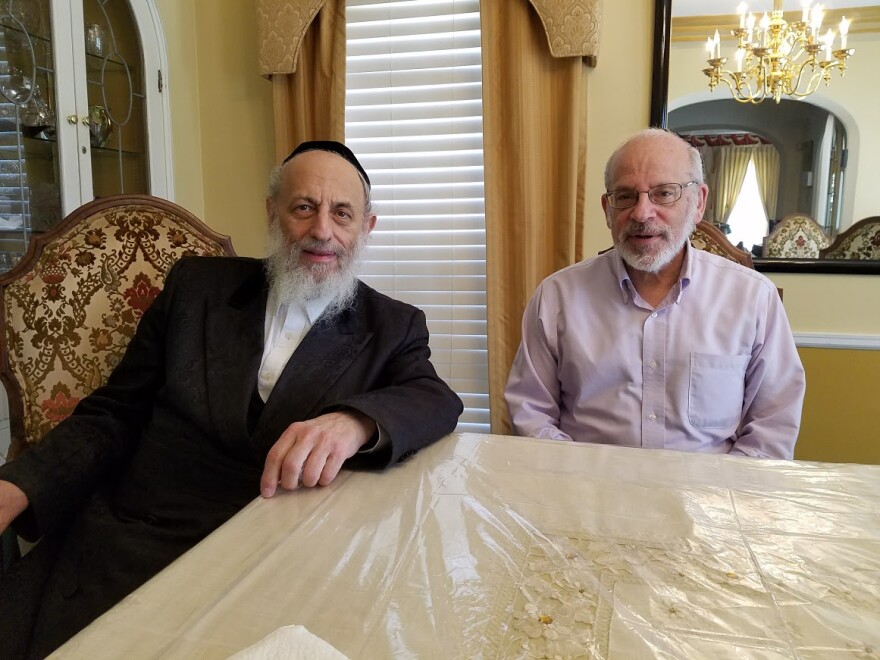At the intersection of 47th and Burleigh in Milwaukee's Sherman Park neighborhood, the Kosher Meat Klub and My Barbershop exist side-by-side. Their coexistence reflects a larger respect between the African Americans and Orthodox Jews living in the area.
The story of the movement of both Jews and African Americans to Sherman Park begins in Milwaukee’s old Haymarket area, closer to the center of town. Haymarket was originally a German enclave, and Eastern European Jews began settling there in the 1880s.
Milwaukee historian John Gurda says that housing in Haymarket was cheap and close to jobs. As for the city’s early African American population, while they came into Haymarket after the Jews, “they begin even earlier in Milwaukee, they go back to the 1830s. By 1850 there were probably 100 African Americans in Milwaukee."
"In time, [the African American] neighborhood became right around the old Haymarket, the old Jewish quarter, west of Schlitz Brewery," he says. "The area a bit north, the Bronzeville section, Third [Street] and Walnut, up to North Ave, that becomes their commercial heart."
The neighborhood was a reception point for Jews, and later African Americans, Gurda explains. In addition to its central location and cheap housing, he says, "Kind of around the fringes there it was pretty mixed, quite a UN of different groups. You had less resistance to newcomers of whatever stripe."
READ: Milwaukee's Diverse Sherman Park: Community Built Through Mutual Respect

Clayborn Benson, executive director of theWisconsin Black Historical Societysays that during any overlap of the two communities in this area, “the Jewish community...cohabitated very well with the African American community.”
But the housing wasn’t great to begin with, and it wasn’t improving. So, both Jews and later African Americans began moving out of the Haymarket-Bronzeville area in the same pattern, north and west.
“The vectors in Milwaukee are really obvious, and they are in most cities," explains Gurda. "You begin at the heart of town and move out in a very predictable direction. You are moving out as you are moving up, looking for a better quality of life for your families.”
The Jews and Eastern Europeans who arrived first began building new homes in Sherman Park as early as the 1920s. Many are still standing today. “You’ve got these great lannon stone brick period revivals," Gurda says. "These great bungalows from the '20s.”
Jewish families were moving into Sherman Park until the 1950s, says Gurda, when the post-WWII pattern became one of secularization. "It was that much more general 'Leave it to Beaver,' 'Father Knows Best' American sitcom of the universal American culture," he explains, "that was kind of a powerful move away [from tradition]," Some traditional or orthodox shuls became conservative. Some conservative synagogues became reform, in order to maintain followers.
“By the 1970s, you have a lot of movement of the original Jewish residents and their congregations in large part to the area east of the Milwaukee River, so the north shore especially,” he details.
As for those properties in Sherman Park? As there was migration outwards, as well as the implementation of federal housing laws, "those homes opened up and African-Americans took advantage," says Benson. He also says it more than the nice homes that attracted them to Sherman Park.
"Washington High School may seem like it’s falling in disrepair today," he says, "but when it was built, it was the best school in the state. It was the cream of the crop.”
By 1980, African Americans had become a significant presence in the neighborhood – 26 percent of its population, says Gurda. And while most Jewish congregations had moved or merged in order to remain viable, one synagogue remained,Beth Yehuda.

Rabbi Michel Twerski’s father had moved the congregation to Sherman Park in 1949, and one goal was to revitalize orthodoxy in Milwaukee. As time passed, the neighborhood became home. "[We] stayed here because families drawn to orthodoxy were generally young families, looking for affordable homes," he recounts. "It reached the point [that] for us to consider to move would be virtually impossible, economically and in every which way.”
"So much benefits from having racially mixed, balanced, solid neighborhoods."
But another reason Beth Yehuda has stayed is to positively impact the community, which has taken repeated hits from a decline in the manufacturing sector. According to congregant Alan Borsuk, "We're very much engaged in the issues of the day, especially locally... I sometimes refer to it as our village in the city. We’re very happy to have this village and to make it a healthy place not only for ourselves but also for everyone around us."
He says that the diversity is prized. "So much benefits from having racially mixed, balanced, solid neighborhoods, and they are in short supply, but this is one of them," he notes.
Clayborn Benson of the Wisconsin Black Historical Society says of Sherman Park today, "Many of those homes are in disrepair, and falling down. But it’s interesting to see how [the neighborhood] still does exist and the Jewish community still maintains their homes in that area, and [African-Americans and Jews] still cohabitate together.”
Benson notes that there are efforts underway to revitalize the area.





